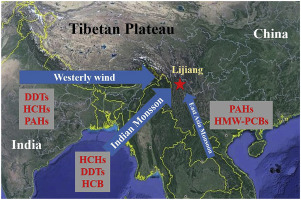Environmental Pollution ( IF 7.6 ) Pub Date : 2017-10-23 , DOI: 10.1016/j.envpol.2017.10.064 Ping Gong , Xiaoping Wang , Jiujiang Sheng , Hailong Wang , Xiaohua Yuan , Yuanqing He , Yun Qian , Tandong Yao

|
Lijiang is a high-altitude city located on the eastern fringe of the Tibetan Plateau, with complex seasonal atmospheric circulations (i.e. westerly wind, Indian Monsoon, and East Asia Monsoon). Very few previous studies have focused on seasonal variations and sources of organic pollutants in Lijiang. In this study, a four-year air campaign from June 2009 to July 2013 was conducted to investigate the temporal trends and the sources of polycyclic aromatic hydrocarbons (PAHs) and organochlorine compounds [including organochlorine pesticides (OCPs) and polychlorinated biphenyls (PCBs)]. The atmospheric PAH concentrations in winter are 2–3 times of those in summer, probably because of the combined result of enhanced local emission and long-range atmospheric transport (LRAT) during winter. Traffic pollution was the primary local source of PAHs, while biomass burning is the dominant LRAT source. OCPs and PCBs also mainly underwent LRAT to reach Lijiang. The peak concentrations of most of OCPs occurred in pre-monsoon season and winter, which were carried by air masses from Myanmar and India through westerly winds. As compared with other sites of the Tibetan Plateau, without the direct barrier of the Himalaya, Lijiang is easily contaminated by the incursion of polluted air masses.
中文翻译:

高海拔城市中大气多环芳烃和有机氯化合物的季节性变化和来源:四年观测的证据
丽江是一个高海拔城市,位于青藏高原东部边缘,具有复杂的季节性大气环流(即西风,印度季风和东亚季风)。以前很少有研究关注丽江的季节变化和有机污染物的来源。在这项研究中,从2009年6月至2013年7月进行了为期四年的空中运动,调查了多环芳烃(PAH)和有机氯化合物[包括有机氯农药(OCP)和多氯联苯(PCB)]的时间趋势和来源。 。冬季大气中PAH的浓度是夏季的2到3倍,这可能是由于冬季冬季局部排放量增加和远距离大气迁移(LRAT)的综合结果。交通污染是当地多环芳烃的主要来源,而生物质燃烧是主要的LRAT来源。OCP和PCB也主要经过LRAT到达丽江。大多数OCP的峰值浓度发生在季风前的季节和冬季,由缅甸和印度的气团通过西风携带。与青藏高原的其他地区相比,没有喜马拉雅山的直接屏障,丽江很容易被污染的空气污染。











































 京公网安备 11010802027423号
京公网安备 11010802027423号